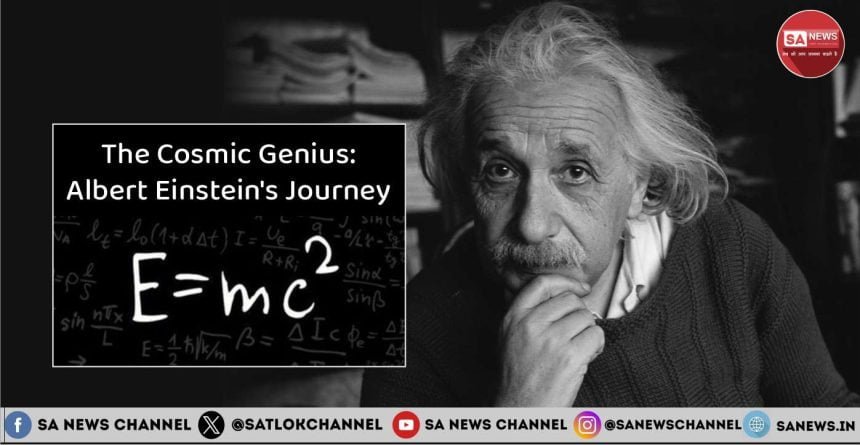When you hear the name Albert Einstein, what comes to your mind? Well for many it is the image of an untangled haired genius whose name is synonymous with innovation and unprecedented scientific contributions. Being one of the most influential scientists in history his work revolutionized the field of physics. Albert Einstein was a theoretical physicist born on March 14, 1879, in Ulm, Germany.
- Key Points Covered in this Blog on Einstein’ life and work:
- The Unruly Genius: Albert Einstein
- Some academic challenges faced by Einstein during his early education included:
- Forsaking German Citizenship
- The Einstein Effect: How One Man Changed the Course of History
- The Passionate Pursuit of Curiosity, 1905: Einstein’s Milestone Year
- The essence of Marriage and Family Life
- Catching the Limelight in scientific scene
- Second Marriage and the time of World War I
- “The Spark of Imagination: Major contributions of Albert
- When He decided to move from Nazis attack
- The Visionary Physicist met his Death
- Famous for his extraordinary innovations but left without understanding the theory of God
- He who does not believe in God is guilty of God.
- Unknown Facts about Albert Einstein:
- Connect With Us on the Following Social Media Platforms
Key Points Covered in this Blog on Einstein’ life and work:
- Birth and Early Life
- Forsaking German Citizenship
- Early Career
- 1905: Einstein’s Milestone Year
- Marriage and Family Life
- Catching the Limelight
- Second Marriage
- Major Contributions of Albert
- Moving to America
- Death
- Conclusion
The Unruly Genius: Albert Einstein
At the tender age of five, Albert was given a compass by his father, Hermann Einstein which ignited his curiosity to explore how exactly that works. He was fascinated by the needle always pointed towards the north. By the age of 10, he had shown exceptional interest in mathematics and physics in school. All of those early life experiences laid the foundation of his insatiable curiosity and man of intellectual explorations.
Some academic challenges faced by Einstein during his early education included:
1. Language transitions: Moving between countries led to language challenges, Einstein’s first language was German, but his family moved to Italy for a short time where he had to learn Italian upon returning to Germany he had to transition back to German, which impacted his education.
2. Hate for Conventional Education: Einstein didn’t like regular school. Teachers made him mad because teachers focused on memorization rather than encouraging independent thinking and problem-solving.
Forsaking German Citizenship
He was born in the time of the German Empire, In 1896 at the age of 17 Einstein enrolled at the Swiss Federal Polytechnic (ETH Zurich) in Zurich, Switzerland to begin his study in the field of physics and mathematics later on in 1899 he renounced his German citizenship while living in Switzerland.
■ Also Read: Healthy Heart Tips: Your Heart: A Symphony of Health – A Comprehensive Guide to a Strong and Vibrant Life
The reason behind renouncing their citizenship is that at that time Germany was under the control of Kaiser Wilhelm II and there was mandatory military service for civilians, which included compulsory army training so the decision allowed him to avoid the compulsory military training and pursue his academic and scientific interests freely in Switzerland, where he had enrolled at the Swiss Federal Polytechnic.
The Einstein Effect: How One Man Changed the Course of History
After acquiring the diploma from the Swiss Federal Polytechnic in 1900, He spent one and half years trying to acquire a junior-level lecturing and research position but he couldn’t get that. Ultimately Einstein took a different path by securing a job at the Swiss Patent Office in Bern, Where he worked as a patent assistant examiner. Individuals who had made inventions would come to present their creations, seeking financial credit and legal recognition. Along with his work of reviewing patent applications, Einstein also spent time thinking deeply about the mysteries of the universe.
The Passionate Pursuit of Curiosity, 1905: Einstein’s Milestone Year
While he was completing his studies and working in the Patent Office in Bern, Einstein was working on some research papers which got published in journals in 1905. This year is often referred to as his “annus mirabilis” or miracle year because Albert Einstein published four groundbreaking papers that significantly advanced our understanding of fundamental concepts such as space, time, mass, and energy. These papers strengthened Einstein’s reputation as one of the most influential scientists of the 20th century.
The essence of Marriage and Family Life
In 1903, Albert Einstein entered into matrimony with Mileva Maric, a fellow physicist and intellectual companion. The couple went on to have two sons, Hans Albert and Eduard. Mileva provided great support to Einstein, contributing significantly to his success during this crucial period.
Catching the Limelight in scientific scene
Shortly after the publication of his breakthrough papers in 1905, Albert Einstein slowly gained prominence in the European scientific scene. In 1908, secured a teaching position at the University of Bern allowing him to leave his job at the Patent Office. Some years later, in 1919, the verification of his theory of relativity occurred during a solar eclipse. The dramatic validation of his theory made a splash in the media, and his name became known around the world. In 1921, only two years later, Einstein was awarded the Nobel Prize in Physics, due to his explanation of the photoelectric effect.
Second Marriage and the time of World War I
The second marriage of Albert Einstein was with Elsa Einstein, née Einstein. She has been his first cousin from his father’s side and his second cousin from her mother’s. They got married in 1919, just shortly after the Einstein divorce from his first wife, Mileva Maric. After their divorce, Albert moved back to Berlin, Germany. Einstien’s arrival in Berlin was immediately interrupted by the outbreak of World War First.
“The Spark of Imagination: Major contributions of Albert
Albert Einstein made a significant contribution to the field of Science and physics. Some of them are the following :
1. Photoelectric Effect: In 1905, he interpreted the photoelectric effect, proving that light had wave-like and particle-like properties. He proved that when light interacts with any matter then it behaves as discrete packets of energy called photons rather than a continuous wave. This helped in the foundation of quantum mechanics, and for his contribution to the understanding of the photoelectric effect, Einstein was awarded the Nobel Prize in Physics in 1921.
2. Brownian motion: The theoretical model by Einstein on Brownian motion provided support to the atomic theory, which hypothesized the existence of small particles, atoms, and molecules, that constitute matter.
3. Theory of Relativity: In 1905, Einstein formulated the special theory of relativity and later on in 1915 he formulated a general theory of relativity. The special theory of relativity revolutionized concepts of space, time, and motion and brought about theories of time dilation and the mass-energy equivalence also known as E=mc2 (Where E is energy, m denotes the Mass and c is the speed of light squared.). The general theory extends the work into gravitational fields, describing it as curvature in spacetime.
When He decided to move from Nazis attack
It was his decision, brought on in 1933 to migrate to America, that became the turning point in Albert Einstein’s life and career. Fleeing persecution by the Nazis in Germany, Einstein sought refuge at the Institute for Advanced Study in Princeton, New Jersey. His presence in America introduced new ideas and developments, firmly establishing his reputation as among the greatest minds of the 20th century.
The Visionary Physicist met his Death
All his life, Einstein fought for the causes of humanitarianism, civil rights, and world peace, while strongly denouncing war, militarism, and atomic armaments. Even in old age, despite his weakening health, he did truly devote himself to the cause against injustice, intolerance, and inquiry into science, so leaving a glorious legacy that has inspired people all over the world. Albert Einstein passed away from an abdominal aortic aneurysm on the 18th of April, 1955, in Princeton, New Jersey, at the age of 76 years.
Famous for his extraordinary innovations but left without understanding the theory of God
It’s amazing how someone as intellectually curious as Albert Einstein never deeply questioned the fundamental mysteries of existence, why life begins and ends, and the intricacies of the human body. He didn’t identify as an atheist but didn’t believe in the existence of God and His super powers. However, it’s just his personal experience regarding God.
■ Also Read: Who is god of world Explained
Spiritual matters remain mysterious for him despite scientific advancements, as only true saints can unhide them like the way, at present, Saint Rampal ji Maharaj ji has unraveled the spiritual books of all the religions and shown the world that there is one Supreme God who exist and can be seen. There is Nothing which does not have the hand of God in its existence. God has created this beautiful mind, body and soul and the whole body is credited to God.
He who does not believe in God is guilty of God.
To know all about God and His creation please read the book Gyan Ganga. To download it free please download the app Sant Rampal Ji Maharaj from Mobile Play Store.
Unknown Facts about Albert Einstein:
- Born in Germany, Einstein lived in Italy, Switzerland, Czechia and the United States, where he settled in Princeton, New Jersey.
- Einstein was a slow speaker, beginning at age 2, and had trouble in school with learning and certain subjects.
- He was accepted into the Swiss Federal Polytechnic School in 1896, despite initially failing the entrance exam.
- Einstein obtained a Ph.D. in physics in 1905, the same year he published four groundbreaking papers.
- The famous equation E=mc² describes how matter can be converted into energy.
- Einstein’s theory of relativity explains how objects affect space and time, particularly in enormous objects like planets.
- He was an accomplished violinist, starting lessons at age 5 and playing in benefit concerts with famous violinists.
- Einstein hated wearing socks and had iconic unkempt hair, which became that way after he had his first child.









